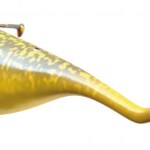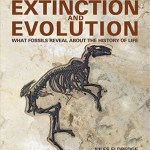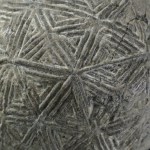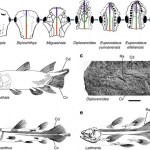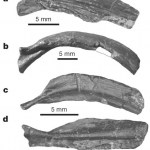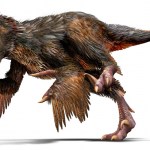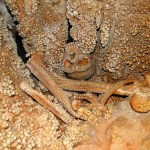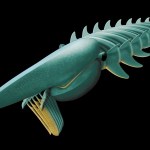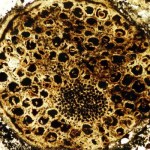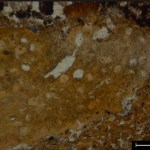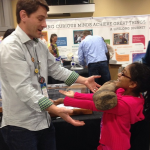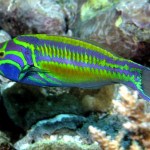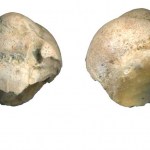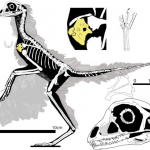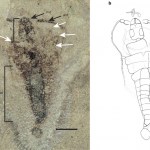Conodonts are strange and extinct animals that left behind lots of fossils: their teeth. Practically nothing else but teeny-tiny, jagged, pointy teeth. I remember when the animals themselves were total mysteries, and no one even knew what phylum they belonged to -- it was only in the 1980s that a few eel-like soft tissue fossils were found, and they were recognized as chordates (very small chordates, on the order of millimeters to centimeters long) with big eyes and membranous fins.
And now today I find two artistic reconstructions of the conodont animal that please me.
Nix Draws Stuff…
fossils
The Tully Monster has been an enigma for half a century. Now it's been reconstructed on the basis of analysis of 1200 specimens.
That thing is weird. It's been extinct since the Carboniferous, though, so we're not going to be catching any nowadays, unfortunately. Note the eyes on stalks; the tubby body; the long 'snout' terminating in a toothy jawed mouth. People have been grappling with its taxonomic identity for decades, and it's been labeled as various kinds of worms, or a mollusc, or an odd relic of some Cambrian phylum.
The latest comparisons, though, have convincingly identified on…
Last night, I watched an excellent documentary, Dinosaur 13, so I'm going to recommend it to you all -- it's available on Amazon streaming video and Netlix. It's the story of the fossil T. rex, Sue, and it's enthralling and depressing.
The fun part is the beginning, when some commercial fossil hunters discover tyrannosaur bones eroding out of a hillside in South Dakota. I had some mixed feelings -- those bones belong in a museum, not serving for profit! -- but it's clear that this team from the Black Hills Institute were pros, and were also skillful preparators. It's a difficult balance,…
Over the last several months, a lot of great books on fossils and evolution (as in paleontology) have come out. I've selected the best for your consideration. These are great gifts for your favorite science-loving nephew, life science teaching cousin, or local school library. Actually, you might like some of these yourself.
Let's start off with a kid's book: Grandmother Fish: a child's first book of Evolution by Jonathan Tweet.
From the blurb:
Grandmother Fish is the first book to teach evolution to preschoolers. While listening to the story, the child mimics the motions and sounds of our…
A little archaeological conundrum found its solution this morning. At an excavation in Motala in the early 00s, colleagues of mine found a cupped piece of hard, greyish brown material with a distinctly patterned inside. They interpreted it as a piece of a lost-wax casting mould and suggested in a 2004 publication that it was for a Viking Period tortoise brooch. I've never seen the find live, but I could tell from the pictures that the pattern was certainly not from the Viking Period. I wrote in my 2011 book about the area (p. 119), “the object in question has a shape and a geometrical…
Ken Ham says something stupid and dishonest again.
https://twitter.com/aigkenham/status/662450677625569280
The fish that forgot to evolve? Here’s the difference between observational and historical science: ow.ly/Ug1wU
If you bother to read the awful article, it includes a standard creationist canard: Coelacanths haven't changed a bit over their long history, and this disproves evolution.
Well, this fish apparently forgot to evolve for 65 million years! You see, the living coelacanth is easily recognizable from the fossils. Despite having supposedly “primitive” features, many of these…
John Hawks makes a very good case that Homo naledi is a distinct species from H. erectus. He persuaded me, anyway, and it's well worth reading.
Also entertaining. There is some savage snark in there aimed at Jeffrey Schwartz (oh, man, I've long known Schwartz as a hack, not for his anthropology, but for his atrocious abuse of genetics) and Tim White. Data, evidence, and inside baseball!
Turtles are nifty animals, with a remarkable adaptation: they've taken their ribs and shifted them outside their appendicular skeleton, flattened and expanded them, and turned them into a shell. It's a clever twist, and it doesn't require any magic -- just a shift in timing during development, with a little extra signaling. The molecular biology and development explain mechanistically how it happened, and we also have fossils of some of the in-between states.
Odontochelys, a 220 million year old fossil, for instance, is a good example of a turtle ancestor that's got some of the bits but not…
This new movie, Jurassic World, is stirring up a fascinating love/hate reaction from paleontologists. We all love to imagine dinosaurs resurrected, and the movies give us an image of what they'd be like, so everyone is happy to see that…and it also inspires new enthusiasm for fossils, so it helps lead to better support for good science. But at the same time, couldn't they at least get the science right?
Kirkland, the state paleontologist at the Utah Geological Survey who has been involved in the discovery of 20 dinosaurs including the Utahraptor, admits such Hollywood blockbusters could…
This is one of the loveliest fossils I've ever seen. They are the bones of a Neanderthal, found in a cave in southern Italy, and although they've been calcified by mineral-rich water trickling through the cave where they were found, it's an almost complete skeleton, with the bones all intact.
That's the grisly part of the story. This person apparently fell into a hole in the karst landscape and was trapped -- he's presumed to have starved to death there. There were no predators able to reach him, either, so his body decayed in place, his bones slumped into a pile, and the slowly accumulating…
Anomalocaris has always been one of my favorite Cambrian animals -- it was so weird, and it was also the top predator of the age, making it the equivalent of T. rex. The anomalocarids were also a diverse and successful group, so wouldn't you know it…it also had a distant filter-feeding cousin in the Ordovician. This is Aegirocassis benmoulae.
Isn't that beautifully bizarre? The great appendages on the front of the animal have been modified to form a filter-feeding apparatus. It was also a real monster, over 2 meters long.
You want to know more? One of the discoverers, Peter van Roy, has…
Creationists are much vested in the idea of "suddenly" -- they love the idea of inserting the fingersnap of God into every abrupt transition. This is why they are infatuated with the Big Bang and the Cambrian Explosion, and why they flirted with the idea of renaming "Intelligent Design" to "Sudden Origins" theory. If something had no antecedents, no gradual build up, well then, we have to explain it with "God did it!".
Unfortunately, the media plays along with it. I found a bit of scientific misinformation on the Raw Story -- such obvious stupidity that anyone with any basic training in…
Stinky stuff! This fits perfectly with my biased preconceptions. So here are two examples of chemistry used to analyze things you'd normally run away from.
The oldest traces of human poop have been dug out of a cave in Spain — and it's Neandertal poop. It's about 50,000 years old, and it's been reduced to a compressed, thin smear of organic compounds, so I guess it isn't actually so stinky anymore, but there was enough of it to analyze chromatographically. In case you've wondered your whole life about what Neandertal poop would look like, here you go.
Microphotographs of a slightly burned…
Guest Blog By X-STEM Speaker Aaron A. Alford, PhD, MPH, PMP
Hands-on learning and human connections are essential to STEM education. Without exception, all of the scientists that I know were inspired to enter STEM career tracks by someone who helped them make an emotional connection to science and discovery.
As a scientist and an educator, I was absolutely thrilled to be a part of the X-STEM Extreme STEM Symposium and the USA Science & Engineering Festival in Washington, D.C. at the end of April. Both events provided a grand opportunity to interact with students and learners of all types…
For the first time, researchers have transformed induced pluripotent stem cells (iPSCs) into specialized bladder cells. Meanwhile the development of iPSCs from normal cells has been shown to depend on two proteins necessary for the induction of a glycolytic state. In order to make iPSCs, researchers have previously needed to collect significant amounts of skin, bone marrow, or blood from a donor, but researchers have demonstrated a new method that requires only a single drop of blood. In the future, you may be able to prick your finger, send a drop of blood to the lab, and have them…
I've mentioned the Earthviewer app from HHMI before: think of it as a bit like Google Earth, only you can dial it back to any period in the planet's history. There have been a couple of developments: it's also available for Android, and it's added some new features, including tracking for major fossils. So now you can see the long strange journey of Tiktaalik's bones on the screen.
They're also making available a lovely big poster of earth's history. This year, we here at UMM are putting together a teacher training program to be implemented in the summer of 2015, and it's going to be a lot of…
It's not the Koh-I-Noor or the Empress Eugenie Brooch or whatever my wife is wearing right now, it's this:
It's a small, broken fossil shell, collected from a fossil outcrop and transported 110 kilometers to a hole in the ground in Italy. Close inspection reveals that before it was broken, there was a pattern of abrasion in one spot that suggests a hole had been drilled in it and a loop of sinew threaded through it. Although most of it has been worn away by time, bits of material in microscopic pits on its surface reveal that once, this shell had been painted with red ochre.
It doesn't sound…
Another feathered dinosaur has been found in China, prompting Ken Ham to dig in his heels and issue denials.
Yet another supposed “feathered dinosaur” fossil has come to light, again in China. (Dr. Elizabeth Mitchell, AiG–U.S., reported on another Chinese fossil of a supposed feathered dinosaur in April 2012) Now, one headline described the fossil as “almost birdlike,” and the authors of the report in Nature Communications note many features the fossil shares with living birds, particularly those that live on the ground. In fact, Dr. Elizabeth Mitchell and Dr. David Menton (AiG–U.S.) both…
Eugene McCarthy, the author of that crackpot stabilization theory, has discovered my review and is now making a noise on twitter. He's gone from thanking me profusely for mentioning him, to whining that I stole his figures, to complaining that I don't understand his theory at all, all in the last 24 hours.
But here's the fun part. Recall that one of his bizarre claims is that whales did not evolve from terrestrial artiodactyls, but from mosasaurs, mesozoic marine reptiles, instead. But the anatomy shows that mosasaurs are derived squamates, reptiles, with a completely different skeletal…
It always seems to be the case that there are gaps in the fossil record just where things get interesting — probably with good reason, that forms in transition will be relatively rare. One such gap is the period where insects first emerge and begin to conquer the terrestrial world, a period called the arthropod gap, between 385 and 325 million years ago. Here's a new specimen from that relatively barren stretch of time, Strudiella devonica.
a, Photograph of the part. b, Reconstruction of general habitus. Scale bar, 1 mm. White arrows indicate legs visible on part. abd, abdomen; ant, antenna;…
